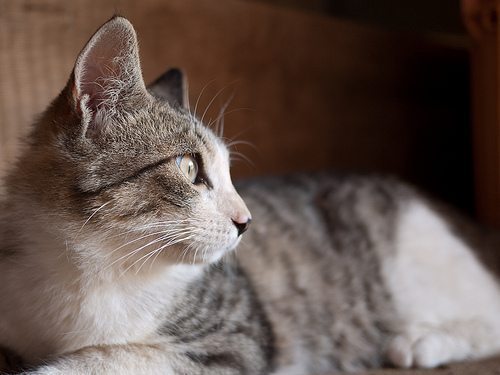Cats are notorious for not drinking enough water. This habit can lead to a disease known as FLUTD – Feline Lower Urinary Tract  Disease. The condition affects the male cat’s lower urinary tract system and bladder more often than the females, due to their narrow urethras. Symptoms include stones in the urinary tract known as Urolithiasis, obstruction in the urethra and inflammation of the bladder.
Disease. The condition affects the male cat’s lower urinary tract system and bladder more often than the females, due to their narrow urethras. Symptoms include stones in the urinary tract known as Urolithiasis, obstruction in the urethra and inflammation of the bladder.
SYMPTOMS
Most people are not aware that their healthy cat could have FLUTD until it is too late. All FLUTD cases are similar, but often have different causes. Watch for the following symptoms so you may take action immediately to prevent your cat from getting this very painful disease. They include:
- Blood in the urine
- More than normal licking of the genitals
- Urinating in other places instead of the litter box
- Crying out or straining when attempting to urinate with little or no results
- Increased frequency of urination
Take your cat to your veterinarian or emergency room immediately if you see your cat experiencing any of the symptoms listed above. A urinalysis will be done, as well as an x-ray or ultrasound and a blood test. The bladder may feel enlarged and full through the abdomen area when examined by your veterinarian, though sometimes it feels small and thick.
THE CAUSES
- Sometimes stress can lead cats to develop FLUTD, so it is important for your cat to have its own litter box that is cleaned on a regular basis.
- Urethral plugs can occur, which are composed of large quantities of minerals and protein. Some contain bits of cellular debris, crystalline minerals, blood cells and tissues.
- Urinary stones may be detected by an ultrasound or x-ray. Struvite and calcium oxalate stones are the most common but may be dissolved through diet, depending on the stone. If your cat eats a lot of fish-flavored and dry foods, it can also lead to FLUTD.
VETERINARIAN TREATMENTS
The first thing your vet will do is a urinalysis, and since it might not be possible for you to bring in a urine sample, your veterinarian will place a syringe through the abdomen and draw out a urine sample. It is a quick procedure that will help empty the bladder. Feeding your cat fluids will flush out the cat’s urinary tract system. If fluid therapy does not work, then the cat will be placed under anesthesia so a needle can be placed on the front leg of the cat in the cephalic vein, and a catheter will be placed in the urethra. This procedure will help flush out the crystals that have formed causing FLUTD and re-hydrate the cat. Finally, surgery may be necessary if the catheterization procedure does not flush out the urinary tract system completely. To reduce the risk of future blockages, the urethral opening is made larger in male cats, which can help prevent future episodes of FLUTD.
AT-HOME TREATMENTS
Below are ways to help your cat be more comfortable at home, and to help prevent the development of FLUTD.
- Replace dry food with canned/raw food, or add water to the dry food. Dry food has only 10% water while canned food has 70% water. Stay away from fish-flavored foods, and look for foods that increase the need for your cat to drink water.
- Drinking Fountains for cats are irresistible and can be found at your local pet store.
- Antibiotics may be necessary to prevent severe pain or damage to your cat; however many FLUTD cases resolve themselves on their own within five days.
- A painkiller called Analgesia may be helpful, or your veterinarian may prescribe an antidepressant such as Amitriptyline.
Reviewed and Approved by Dr. David L. Roberts, DVM
Photo: Courtesy of hkase via Flickr (cc by 2.0)









